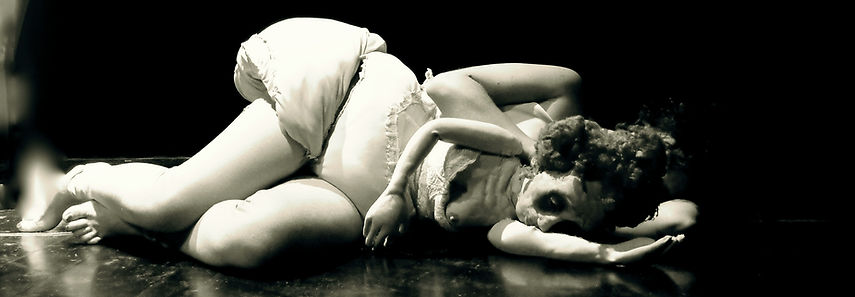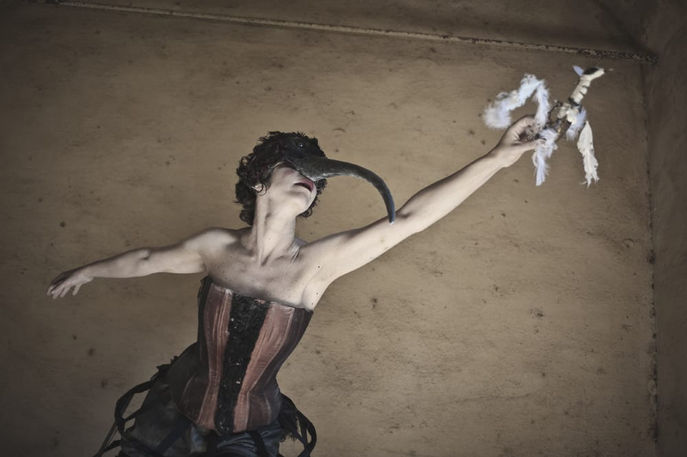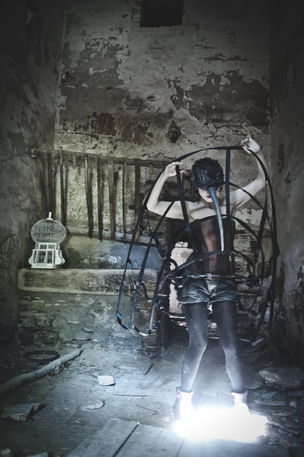m a r i o n e t a s s i n l o b o

Bestiario
Sentimentale
L’uomo fa parte delle specie animali che, quando sono ferite, possono diventare particolarmente feroci.
Gao Xingjian, da Bestiario Sentimentale di Guadalupe Nettel
"Man belongs to an animal species that when injured can become particularly ferocious.”
Gao Xingjian from Natural Histories by Guadalupe Nettel
Una donna uccello - En Cage. Una donna pesce - In Acque profonde. Una donna maiale - Circe.
“Bestiario Sentimentale”, come il bel libro di Guadalupe Nettel, è un trittico di spettacoli in cui appaiono animali come metafore e simboli della donna e del sentimento amoroso. In ogni episodio una metamorfosi avrà luogo, portata in scena da una maschera e una marionetta.
Protagonista dunque una Chimera dalle molteplici forme, prima donna con testa d’uccello, poi uccello con testa di donna, a cui seguirà (ancora in creazione) una rivisitazione della figura della Sirena, donna con corpo di pesce e poi donna con testa di pesce e tacchi a spillo rossi fiammanti, e per ultima la donna maiale, Circe, arrostita e allo spiedo con una mela in bocca, ironico e crudele riferimento alla violenza sessista.
In questo tentativo contemporaneo di portare alla luce chirurgie e trapianti fantastici di figure archetipiche nasce “Bestiario Sentimentale”.
foto di Esteban Puzzuoli
all pictures by Esteban Puzzuoli
A bird-woman - In a cage. A fish-woman - In deep-water. A pig-woman - Circe.
Sentimental Bestiario is a triptych of shows in which animals appear as metaphors and symbols of the woman and the feeling of love. In each episode a metamorphosis will take place, embodied on stage by a mask and a puppet.
The protagonist is therefore a Chimera in her multiple forms, first a woman with a bird’s head, then a bird with a woman’s head, followed by (still in creation) a post-modern interpretation of the figure of the Mermaid, a woman with a fish tail which transforms in a woman with a fish head and a woman´s legs wearing flaming red stiletto heels. In the end Circe, the pig-woman, roasted and
skewered with an apple in her mouth: an ironic and cruel reference to sexist violence.
In this contemporary exploration to bring to light surgeries and fantastic transplants of archetypal figures this Sentimental Bestiary was born.
Capitolo I - En Cage

foto di Esteban Puzzuoli
E’ la donna-uccello ad aprire il Trittico. En Cage è uno spettacolo ricco di simboli e immagini poetiche che esplora la condizione dell'essere in gabbia.
Gabbie fisiche e mentali in cui la donna/uccello, essere in origine potente e libero, si rinchiude, in seguito a una caduta, un dolore d'amore che la porta allo stato di prigionia e di attesa, infinita, in cui si consuma.
Is the bird-woman the one who opens the triptych. En cage is a show rich in symbols and poetic images, that explores the condition of being in a cage.
Physical and mental jails in which the bird-woman, being originally powerful and free, withdraws into herself, after a fall, a painful love that brings her into the state of incarceration and waiting, endlessly, in which she decomposes.
Capitolo 2 - In acque profonde / In deep waters_Sirens beyond Andersen
w o r k i n p r o g r e s s

“Se la Storia riporta che esse avevano delle ali e degli artigli, è per dire dell’Amore, che vola e che
ferisce; e se esse dimorano nell’acqua è perché la lussuria è nata dall’umidità”.
Brunetto Latini
«Se mi prendi la voce» chiese la sirenetta «che cosa mi resta?»
“Il tuo desiderio verrà soddisfatto, perché ti porterà sventura.
Soffrirai come se una spada affilata ti trapassasse.”
Hans Christian Andersen
La figura della Sirena diventa uno spunto per parlare del desiderio.
Il desiderio di essere diversi da ciò che si è, di avere qualcosa che non si ha, che non è nella propria natura e che non si può ottenere senza ricorrere a una mutilazione, un’amputazione profonda del proprio essere.
Ma anche del desiderio erotico, della sua forza, della profondità (e oscurità) delle acque in fondo al mar.
If History reports that they had wings and claws, it is a metaphor of Love, which flies and hurts; and if they dwell in water, it is because lust is born from wet.
Brunetto Latini
«If you take my voice» asked the little Mermaid «what do I have left?»
“Your wish will be fulfilled, because it will bring you misfortune.
You will suffer as if a sharp sword was piercing you ”
Hans Christian Andersen
The figure of the Mermaid is a starting point to talk about desire.
The desire to be different from what we are, to have something that we do not have, that is not in our nature and that we cannot achieve without a mutilation, a deep amputation of our true self.
But also the erotic desire, its strength, the depth (and darkness) of the waters at the bottom of the sea.
scarica il dossier artistico del progetto
download the artistic dossier of the project



















